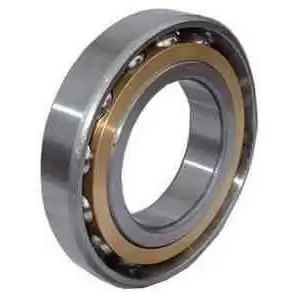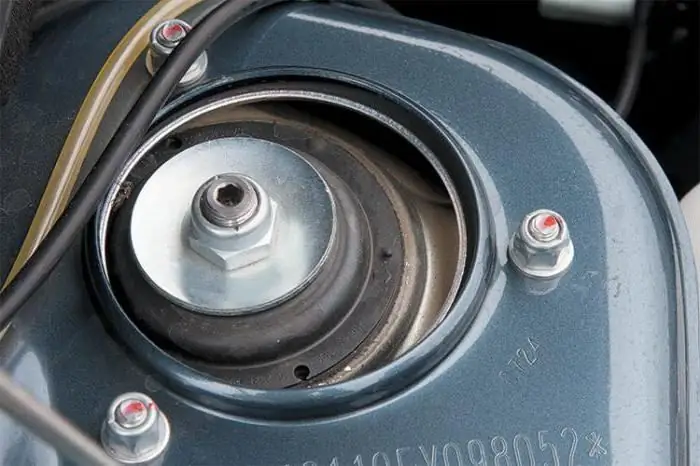2025 Author: Erin Ralphs | [email protected]. Last modified: 2025-01-22 21:14:14
Thrust bearings are elements of the car's front suspension. Their main task is to smooth out shock loads on the body. The failure of these parts does not bode well. In addition to the fact that the suspension and bodywork will wear out faster, the handling of the car will also deteriorate significantly. And this already carries a certain danger for the driver and passengers.
In this article we will talk about what the front strut bearings are, how they are arranged, what they are for and what their principle of operation is. In addition, we will consider the process of replacing these suspension elements using the example of a VAZ-2110 car.

Purpose
A-pillar support bearings are today installed on all passenger cars, regardless of whether they are front-wheel drive or rear-wheel drive. They are part of the mounts that secure the top of each shock to the body.
The support bearings of the front struts are designed to dampen the loads coming from the wheels through the struts to the bodymachines, as well as their uniform distribution. This distribution is achieved due to their special design.
How the front strut support bearing works: photo, description
Structurally, a support bearing is a conventional rolling bearing. Its working elements are either steel balls or rollers made of the same metal. A design feature is the presence of a special separator, thanks to which each of the balls (rollers) is separated from each other and acts as a separate element. This, in fact, allows you to evenly distribute the radial and axial loads on the body.

The bearing itself is enclosed in a steel housing, which can be either solid or collapsible. The last option is repairable. One-piece designs change assemblies.
Varieties of support bearings for VAZ-2110
Front strut support bearings come in four types:
- with built-in ring;
- with detachable inner ring;
- with detachable outer ring;
- single-separated.
The first type is characterized by the presence of special mounting holes. When using such parts, clamping flanges are not used. In addition, the VAZ-2110 front strut support bearing with a built-in ring is equipped with built-in gaskets that ensure constant and maximum rotation accuracy.
Designs with detachable inner and outer rings differ in the location of the latter. In the first case, the outerthe ring is in contact with the body of the device, in the second - internal. By and large, these bearings do not represent much difference for a VAZ-2110 car. But the fourth type of parts is characterized by the fact that its outer ring has a division at one specific point, due to which the rigidity of the entire device increases significantly.

Where are the support bearings
Thrust bearings are located in the engine compartment of the vehicle. Open the hood of the car and pay attention to the bulges of the body on both sides of the engine compartment. These are the places to which the racks are attached. They are also called "glasses", and one of them is usually stamped with a body number. The bearings are mounted on top of the "glasses" and are closed with special rounded caps. They are easily dismantled by hand. After removing the cover, you will find the upper part of the bearing housing. It is attached to the body with three bolts, the nuts from which you will immediately see.
When you need to replace thrust bearings
The construction of the support bearing is strong enough to last for years. But, given the quality of the coating on our roads, it often happens that they have to be changed almost every year.
According to the list of routine maintenance for the VAZ-2110, the replacement of thrust bearings should be carried out after every 100 thousand kilometers. Well, if you have established that they are out of order before the deadline, do not delay the replacement. The running gear, the bodywork, and the elements of the control system will suffer from this.

Signs of A-pillar support bearing failure
Signs of bearing failure, regardless of bearing design, are:
- characteristic knock when driving on uneven surfaces;
- sound like crunching during a banked turn while driving;
- violation of normal vehicle handling.
How to Diagnose a Bearing Failure
To know for sure that it is the front strut bearings that are the cause of the above symptoms, you will need to conduct a simple diagnosis. To do this, it is advisable to invite an assistant. The verification algorithm is as follows:
- Put the car on level ground, immobilize it with the parking brake.
- Open the hood of the car.
- Remove the protective cover of one of the "glasses".
- Place your palm on the "glass" and ask the assistant to shake the car from the same side, so that the corresponding rack works. If the front strut support bearing fails, you will determine its malfunction by the characteristic knock and vibration that accompanies it, which you will feel with your hand.
- Check the opposite rack in the same way.

What will be required in order to replace the support bearing with your own hands
Before you replace the front strut support bearing yourself, make sure you have the following tools on handand tools:
- jack;
- balloon wrench;
- wrenches for 9, 13, 19, 22;
- special puller for steering tips;
- string for strut springs;
- pliers;
- marker, paint or core;
- "shoes" for fixing wheels or a pair of bricks;
- rust control fluid (WD-40 or equivalent).

Change the bearing of the front suspension support with your own hands
- Put the car on a horizontally level surface, apply the handbrake. Secure the rear wheels with "boots" or bricks.
- Remove the front wheel bolts from the side where you are going to change the bearing.
- Lift the car body, remove the bolts, remove the wheel.
- To ensure that after replacing the bearing you do not have to do wheel alignment, apply paint or core marks on the upper bolt of the steering knuckle.
- Using pliers, remove the cotter pin fixing the nut of the ball tip (finger). Unscrew the nut with a wrench to 19.
- Using a puller, press the pin out of the strut knuckle.
- Using a 19 wrench, unscrew the nuts on the bottom of the steering knuckle (2 pcs.). Often they stick, so it is better to treat them with anti-rust liquid.
- In the engine compartment, unscrew the three nuts securing the upper support to the body, using the key on 13.
- Use the strut spring tie to unload the strut. Using keys on 9 and on 22,unscrew the nut securing the support to the rack.
- Dismantle the support and disassemble it.
- Remove the support bearing from it. Install new part.
- Reassemble the removed elements in reverse order.
- Don't forget to check the marks you made on the top knuckle bolt.
- After completing the installation, check how the rack works and if there are any extraneous sounds. If everything is fine, you can check the new part in motion.
How to extend the life of the front strut support bearings
To make bearings last longer, use the following tips:
- Try to avoid driving on broken roads.
- Don't brake hard or pull away with the steering wheel turned to the side.
- If you notice even one of the signs of a failed support bearing, hurry to replace it. This will extend the life of other suspension and steering components.
- If you are going to replace the support bearing, buy only branded parts from well-known manufacturers.
- Check the operation of the racks periodically, listening for extraneous sounds.
Recommended:
What is a connecting rod bearing? Main and connecting rod bearings

The crankshaft of the engine is a body of rotation. He rotates in special beds. Plain bearings are used to support it and facilitate rotation. They are made of metal with a special anti-friction coating in the form of a half ring with precise geometry. The connecting rod bearing works like a plain bearing for the connecting rod, which pushes the crankshaft. Let's take a closer look at these details
Signs of malfunction of the torque converter automatic transmission BMW, Subaru, Mazda Premacy

The torque converter is one of the main elements in the automatic transmission system. Due to it, smooth and timely gear changes are carried out. The first torque converter systems were developed at the beginning of the last century, and today they have been significantly modernized. But, despite all the improvements and technological progress, sometimes the box fails. Let's look at the main symptoms of an automatic transmission torque converter failure in the most popular models
Rear beam "Peugeot Partner" - device, signs of malfunction, repair

Peugeot Partner is one of the most famous French compact vans. This machine is famous for its versatility. The car can carry both passengers and large items. Other features include a simple suspension scheme. It is the same as on many budget cars. MacPherson struts are installed at the front, and a beam is at the back. In today's article, we will talk about how the rear beam is arranged on Citroen and Peugeot Partner cars and what are its features
What is a rear wheel bearing, how does it work and how to replace it?

The running system performs many functions, the main of which is to ensure vehicle controllability. To make the machine maneuverable and safe, it is equipped with a special steering knuckle and a hub between the axles. In order for them to be as reliable as possible, they include two bearings each. Both parts may differ in size and cost, but their design remains unchanged
How to replace a UAZ hub bearing: nuances and analogues

The car uses a lot of technical elements. One of these is the wheel bearing. UAZ is also equipped with them. It is an integral part of any car. After all, it is this bearing that ensures smooth rotation of the driving and driven wheels around the axis. This node is under enormous load. Therefore, it is possible that the UAZ front hub bearing may fall apart. What is the resource of this element, what are the signs of failure and how to replace it? All this later in our article

